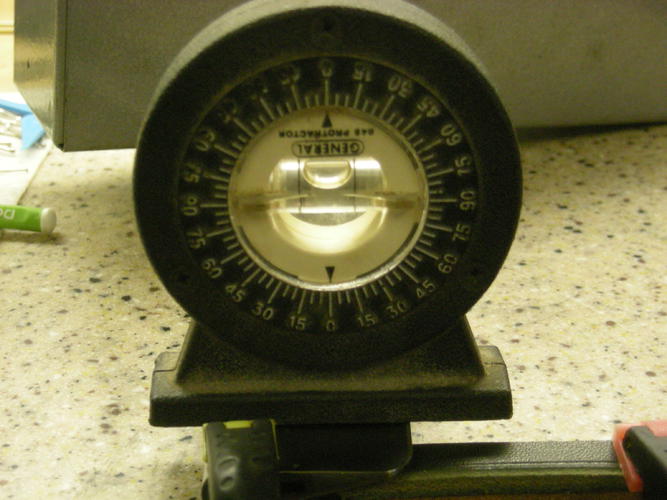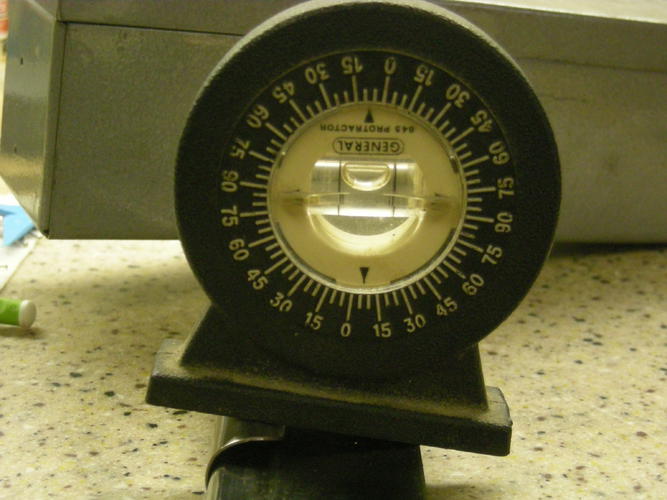Results 41 to 50 of 59
Thread: Latest custom builds
-
07-10-2014, 04:08 AM #41

ah, yes, now I remember. simpletons table. it uses transverse calculations to find the location of tittlemans crest for the purpose of extrapolating theories of a dichotomous nature. (the only words I know the meaning of in that sentence are "I, the and when...."
bring on the tarkus, im ready to feel stupid..........erSilverloaf
-
07-10-2014, 04:13 AM #42

I forgot to multiply by two for the included or total angle
-
07-10-2014, 04:54 AM #43No that's not me in the picture


- Join Date
- May 2013
- Location
- Los Angeles South Bay
- Posts
- 1,340
Thanked: 284
Yeah seems like you guys got it right. tan (alpha) = (1/2)SpineWidth/Blade Width gives you the half angle. So tan alpha = 8/30, or alpha = 14.92 or about 30 deg total.
That's pretty fat cause that piece you hone on is huge! Haha. 30 mm is about a 19/16 blade, but with a 5/8 (16 mm) width spine!! That's a width to spine ratio of about 2:1, giving you about double that of a straight razor angle.
Sharptonn is the frameback piece really that big? Hard to tell from the picture. Course I know nothing about microtomes, maybe that's what they should be.I love living in the past...
-
07-10-2014, 05:23 AM #44

I actually thought about the point where the stone contacts the radius of the frame would be slightly lower than the "equator" but truthfully wasn't sure exactly how to quantify that. Thus I used the dimensions provided with a little figuring to come up with the half angle. I just forgot to multiply by 2.
We're talking -1°or so
-
07-10-2014, 07:11 AM #45

It is about 30 degree angle, and the effect from the hone not touching directly at the diameter is second order about as significant as the effect from the exact position of the cylindrical shim on top of the blade. Overall thats a tolerance of about 2 degrees, so 30 plus/minus 2
-
07-10-2014, 11:11 AM #46Senior Member



- Join Date
- Dec 2011
- Location
- I'm Gonna Spend Another Fall In Philadelphia
- Posts
- 2,006
Thanked: 498
What I did was first build my right triangle. If I divide the frame in half that will give the length of my first side (Side opposite) in this case it will be 8 m.m. (.3149") and Sharptonn said the length of the blade was 30m.m. (1.181") that's from the edge to the tangent point of the frame. That give me my other side length (Side adjacent)
Tan= Side opposite over Side adjacent
So I divide .3149 from 1.181 which gives me .2666"
I then look up in my trusty Trigonometric Table chart .2666 in the Tangent column anf I find it at 14 degrees 56 minutes.
That's of course if I understand Toms interpretation.
Since his diploma doesn't look like his handwriting either.
doesn't look like his handwriting either.
Depending on how he measured if he measured it linearly (perpendicular to the edge)I think my numbers will pan out, but if he measured by measuring the side where the caliper was sitting on the frame Tangent point and up against the edge, then he would be measuring the Hypotenuse not the Side adjacent.
My brain hurts.
I just ran the numbers if Tom measured the Hypotenuse
Cosecant= Hypotenuse over Side Opposite comes to 15degrees 28 minutes
Which is more in ncraigtrn figureings.Last edited by Tarkus; 07-10-2014 at 11:54 AM.
-
07-10-2014, 02:34 PM #47

This is quite amusing, Guys! redneck protractor. NOT the most accurate thing, but should be close! Here we go......
Blade sides are perfectly flat, so one side leveled out and clamped to the workbench...

undisturbed, frameback to edge!

I do think the hone contact point is on the downhill slope of the round frameback making the frameback measurement slightly smaller (say, 15 mm) and the width measurement 29mm from frameback hone contact point to edge. To get angle, would we not double this measurement? I have NOOOOOO idea!
Last edited by sharptonn; 07-10-2014 at 03:13 PM.
"Don't be stubborn. You are missing out."
I rest my case.
-
07-10-2014, 03:30 PM #48No that's not me in the picture


- Join Date
- May 2013
- Location
- Los Angeles South Bay
- Posts
- 1,340
Thanked: 284
Haha it is funny isn't it??
I think where you're a little off is that you leveled the face of the blade, but the "zero" is actually at the centerline and not the face. So when you measure the angle without the frame back you should get something other than zero. Given that starting point your going to get something more than what you're showing now, prob closer to the predicted 15 deg.
You can get the centerline level by measuring the angle of both faces until they are equal in magnitude.
Or you can trace it on paper and measure with a protractor I love living in the past...
I love living in the past...
-
07-10-2014, 03:37 PM #49

heres what i did (feel free to point and laugh). working in construction for years taught me that direct transfer is the most reliable (unless of course you have a table with answers) as each measure you make and record each number can introduce human error. the simplest thing for me without having tables was to draw it out with as few measures as possible. i drew a line perpendicular and square to the edge of the paper, marking it at 30mm. i then drew a semi-circle with a diameter of 16mm to represent the frame/spine, centered on the perpendicular line. then just lines (i only drew one line so as to get my angle since that's all i needed but drew in the second for the purpose of explaining) to connect the "cutting edge" and "hone contact" on the frame/spine. i measured the angle that corresponds to being between the spine and blade face which gave 75 degrees. the angles in a triangle add up to 180 degrees so i took the 75 degree angle from each corner since they are the same, giving 150. the cutting angle that was left was 30 degrees. (plus or minus) simplest way for me but obviously not as accurate as a table. i love the redneck protractor tom! in theory that should give a close measure of the half angle but those bubbles always lie! i havnt met one yet that told the truth, the whole truth and nothing but the truth

Last edited by silverloaf; 07-10-2014 at 03:40 PM.
Silverloaf
-
The Following User Says Thank You to silverloaf For This Useful Post:
sharptonn (07-10-2014)
-
07-10-2014, 03:42 PM #50No that's not me in the picture


- Join Date
- May 2013
- Location
- Los Angeles South Bay
- Posts
- 1,340
Thanked: 284
Yup, it all agrees. Sharptonn's method should work as well, but like I said I think he's measuring the delta angle between the face of the blade and the frameback, not the centerline. Measuring from the centerline will get much closer to the math and to your sketch. We all need to exercise our brains from time to time right??
 I love living in the past...
I love living in the past...
-
The Following 2 Users Say Thank You to RoyalCake For This Useful Post:
sharptonn (07-10-2014), silverloaf (07-10-2014)


 86Likes
86Likes LinkBack URL
LinkBack URL About LinkBacks
About LinkBacks







 Reply With Quote
Reply With Quote

